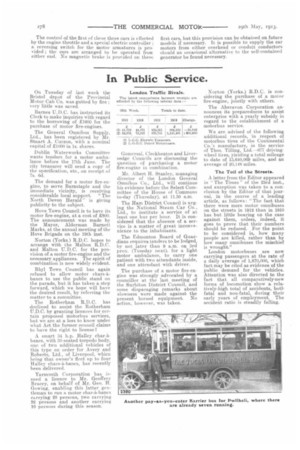The L.C.C. Petrol-Electric Trams.
Page 9

Page 10

If you've noticed an error in this article please click here to report it so we can fix it.
First-published Particulars of the Plant Bought from W. A. Stevens, Ltd.
We may point out that the London County Council has been earnpell:,11 to consider the adoption of sonic self-contained power plant for a certain section of its system, in the East End of London, on acisount of local objections which have been urged to the overhead or the underground-conduit system in this particular instanoe. We think the Council was well advised to try experiments with the Stevens system of petrol-electric propulsion, as its special characteristics yield considerable promise of its satisfactory adaptation on a large scale to certain classes of rail traffic. The present experiment, therefore, will be watched with exceptional inter
est in this connection.
Three L.C.C. cars are to be fitted, and with these exhaustive experiments will be carried out ; the first of those is complete. Already the requirements of the Local Government Board inspectors have been satisfied, and the machine, we learn, has surpassed its builder's anticipations. The experimental cars are being fitted up at the L.C.C. Charlton depot.
The trucks have been specially designed and manufactured by the engineering department of the L.C.C. The bodies have been taken from three of the old horsed cars. There are two electric motors for each truck, and these are geared to the axles by B to 1 reductions ; the motors are of the series-wound interpolar type. The maximum load on each motor is 20 b.h.p., which is considerably below their load capacity, and it is found that either of the electric motors is capable of running the ear on level roads. The electric generator is of the same type as that used on the well-known 40 h.p. Tilling-Stevens petrolelectric omnibus. It is of the shunt-wound inter-polar class, the maximum voltage being about 350. With regard to the petrol engine, this has a bore of 41 in. and a stroke of 54 in., and develops over 40 b.h.p. The engine arid electrical generator are both mounted on a, pressed steel frame, which is suspended on the platform bearers at one end of the ear, in such a way that the power unit is easily removable, and can be exchanged in the case of a breakdown for a similar unit in a very short space of time.
The radiator, which is of the circular Solex type—a model which has been adopted exclusively on recent examples of this maker's motorbus chassis, is at the opposite end of the car, but under the stairs in the same relative position. The fan for this radiator is mounted directly on the shaft of a small series-wound electric motor.
The control of the first of these three ears is effected by the engine throttle and a special electric controller ; a reversing switch for the motor armatures is provided; the cars are arranged to be operated from either end. No magnetic brake is provided on these first cars, but this provision can be obtained on future models if necessary. It is possible to supply the car motors from either overhead or conduit conductors should an occasional alternative to the self-contained generator be found necessary.






























